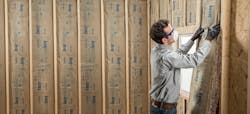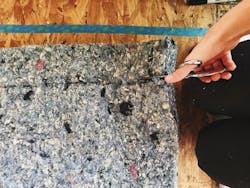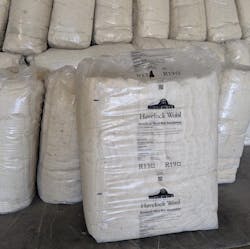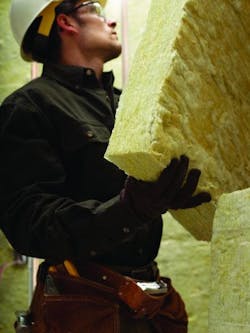5 Insulation Products That Seal the Deal
Insulation manufacturers want your recycled glass. From beer and soda bottles to pickle and mayonnaise jars, recyclables kicked to the curb are ending up in the attic, as manufacturers continue to boost the amount of recycled glass used to make batt and blown-in insulation. With homeowner interest in energy efficiency anticipated to drive insulation category growth to $10.3 billion in 2019 , according to The Freedonia Group, it’s getting harder for insulation manufacturers to find enough glass to fill the bins.
“We use 10 railcars of crushed glass every day,” says Brett Welch, senior product manager for Shelbyville, Ind.-based Knauf U.S. “So even as sustainability has been a driver in getting our recycled content north of 60 percent, there remains some market misconception about availability of recycled materials. We need industrial-scale amounts of glass, so we’re partnering with different industries and municipalities to raise awareness about how to get it to us.”
Insulation markets are booming, even as the home building industry has taken a more systems-based approach to heating and cooling that incorporates other products and construction methods into a wider, whole-house effort to reduce air leaks and improve energy efficiency.
UltraTouch denim insulation contains 80 percent post-consumer recycled natural bluejean fibers, providing effective sound absorption and thermal performance, the company says. Perforated batts allow for quick and easy off-size cavity installations, and the insulation meets ASTM testing standards for fire and smoke ratings, fungi resistance, and corrosiveness.
“The energy codes are really beginning to appreciate the fact that insulation doesn’t work in isolation; that it needs to be paired with wider efforts to mitigate air leakage,” says J.R. Babineau, research engineer and principal building scientist for Denver-based Johns Manville. “Broadly, the industry is realizing you can’t keep increasing energy efficiency just by cramming in more insulation, and that systems approach has been one of the biggest changes our industry has seen.”
In addition to taking a harder look at insulating door and window openings, insulation specialists are finding air leakage at the rim joist and at the top of wall systems, too, particularly walls directly below an insulated attic or crawlspace. Spray foam has consequently surged in popularity as a product that can deliver air sealing as well as insulation. It also comes with a higher price tag and, once applied, is more difficult to remove.
EcoTouch insulation with PureFiber Technology offers exceptional stiffness and recovery characteristics with no additional handwork needed for high-quality installs, the manufacturer says. It’s easy to cut and split, with less dust, simplifying installation around irregular cavities and common obstructions. Available in R-values from 11 to 49.
Babineau says one of the more interesting things about spray foam is how it has disrupted traditional concepts of manufacturing, production, and distribution in construction supply chains. After getting into spray foam in 2009, Johns Manville launched its free TechConnect service to help train contractors to boost productivity, yield, and installation quality. “Batts and board products just go up, but spray-in takes a little more training to do well,” Babineau says. “We might produce the chemical, but the guy pulling the trigger on the gun is manufacturing the product right there in the wall cavity, and that’s been a big aha moment for us.”
Homeowner attention to energy efficiency has peaked in tandem with interest in indoor air quality, opening a market for manufacturers touting the overall healthfulness of their products in addition to their sustainability. UltraTouch (recycled blue-jean denim) and Havelock (sheep wool) insulation are both products that can be installed without use of protective equipment and that resonate with consumers that have high eco-awareness.
Wool insulation is hypoallergenic, doesn’t off-gas, and can remove harmful chemicals such as formaldehyde, nitrogen oxides, and sulfur dioxide from the air. Wool fi bers absorb and release moisture against 65 percent relative humidity, do not act as a mold substrate, and absorb 90 to 95 percent of airborne sound.
“With the increased number of chemically sensitive people, [consumers] are starting to home in on the materials that surround them, looking for the culprit,” says Jessica McNaughton, president of UltraTouch and Havelock distribution company CaraGreen. “Insulation is one of the places homeowners still look to to limit exposure to toxic elements. Denim and wool will cost more than fiberglass, so you have to be willing to pay a premium for a healthier material, but most people, once educated, understand that.”
Left unsaid is the need for organic materials such as wool, cotton, and cellulose to be treated with chemicals to offset their flammability, a concern that has some homeowners defaulting to cheaper, inflammable fiberglass. Contractors should also be prepared to help educate homeowners about the difference between wool insulation from sheep and mineral wool insulation, an inorganic mineral fiber developed from coal or volcanic basalt.
Mineral wool batts are made of inorganic fibers derived from volcanic rock that are then enhanced with glass fibers. TempControl batts and Sound & Fire Block batts feature high-density fibers to help delay the spread of fire and reduce noise transfer in interior walls and between ceilings and floors.
But regardless of the medium, insulation makers say the message is the same: Insulation performs better (and homeowners need less of it) when combined with a systematic approach to sealing air leaks throughout the building envelope.
“Air sealing, in addition to insulation, specifically has become a bigger and bigger focus with contractors, code officials, and builders as we are mandated to build tighter and tighter,” Welch says. “So even as spray-ins deliver air sealing, there are also contractors out there with skilled air-sealing crews that can deliver the same performance with fiberglass at a lower cost, and builders need to factor in the total cost of labor and materials for the approach they take.”
That, and keep the empty bottles coming.




